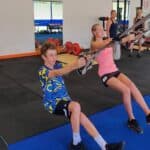Youth Strength
We build strong, confident, and resilient young athletes with expert-led strength and movement coaching.
For Youth Athletes (Ages ~11–18).
What is it?
A structured program for youth athletes who want to improve physical performance, prevent injury, and train with purpose.
Grounded in the Youth Physical Development Model and aligned with the ASCA Position Stand on Resistance Training for Children & Youth, the program is developmentally appropriate, safe, and sport-relevant.
How it works:
All athletes begin with a 1:1 movement assessment and screening session to:
- Identify strengths and weaknesses
- Understand injury history or restrictions
- Review athletic goals and sport-specific needs
From there, the athlete begins their individualised strength program in our supervised small-group sessions.
Athletes train 2× 1hr per week for optimal development — enough frequency to drive adaptation while allowing for recovery.
Session schedule: Mon/Wed 330 OR 430 OR 530. Tu/Thu 430 OR 530.
There is also the option of joining 6am or 7am Tu-Fr if you cant make 2 after school sessions. We want to make sure your week is balanced.
10-week term format, aligned with NSW school terms.
We cap each group at 8 to ensure personalised coaching. Athlete progress is tracked every session, and every athlete is reassessed after each 4-week block to adjust programming as needed.










Session format:
Every session includes:
- Warm-up & mobility
- Technical skill acquisition
- Power & strength training
- Cool down, stretching, and recovery
Athlete-led tracking of sets, reps, weight, tempo, rest, and notes — encouraging accountability and self-awareness.
Investment:
- Initial 1:1 Assessment: $95
- 10-Week Training Block: $800 (2 sessions/week)
Includes:
- Term in-studio coaching block
- Program development & delivery
- Constant supervision & reassessments
- Training log & ongoing progress reviews
What can you expect:
All youth participants become:
- More confident in themselves/how they move — at school, in training and competition
- Stronger, faster, and more coordinated for life and sport
- Better prepared for the demands of life, sport and growth
- More resilient and lower risk of injury due to smart programming and movement coaching
- Equipped with a solid foundation in strength training they can build on for life
Additional info:
- Youth wanting extra support for sport-specific performance can book a 1:1 coaching session.
- Our strength programming experience extends across all sports.
- Overseeing the sessions, athletes progress and programming is Jeremy Rae:
- Accredited Exercise Physiologist (University of Sydney, 2002)
- Member – Exercise & Sports Science Australia
- Certified Strength & Conditioning Specialist – NSCA (2007)
- Level 2 Coach – Australian Strength & Conditioning Association (2013)
Youth Strength is part of TRIBE – A coaching-based strength and movement system built for all stages, Youth to 65s+
Whether you’re just learning how to move well, ready to get stronger, or chasing performance, TRIBE Training gives you a clear path forward.
Built on the 3-tier TRIBE Training system — Movement Foundations, Strength & Resilience, and Performance Prep — every session meets you where you’re at and helps you progress with purpose.
Youth Physical Development model:

For youth athletes, training 2–3 times per week provides the optimal balance between progressive overload and recovery — essential for safe, effective development.
We’ve designed this program to run twice per week — the ideal frequency for developing strong, capable young athletes without overloading their growing bodies.
1. The Right Dose for Progress
Training twice a week gives consistent strength and coordination gains, while leaving enough space for growth, recovery, and other sports. It’s the sweet spot for results without excess.
2. Built-In Recovery
Youth athletes are still growing, and rest is just as important as training. Spacing sessions across the week helps prevent injury, supports energy levels, and lets the body adapt safely.
3. Builds Habits That Stick
Training twice a week fits into a busy schedule without becoming overwhelming. It teaches structure, consistency, and the discipline needed to thrive in sport and in life.
4. Supports All-Round Development
Many athletes play multiple sports. This format complements, rather than competes with, those activities — helping your child move better, stay injury-free, and get more from everything they do.
5. Backed by Evidence
Leading research — and decades of coaching experience — show that 2–3 sessions per week maximises gains in strength and power, while minimising fatigue and burnout.
